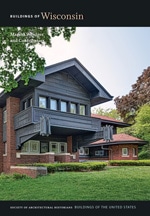
Long rows of Italianate commercial buildings, most of them of the same two-story height and the same setback, make Watson Street one of the most striking downtowns in Wisconsin. The district owes its remarkable visual coherence to disastrous fires in 1868 and 1869 that laid waste to most of the downtown. Rebuilt over the next two decades, construction largely came to a halt in the 1890s, and consequently the district seems forever frozen in the late nineteenth century, despite later alterations to storefronts. There are some newer buildings, however, notably the austere and imposing former First National Bank at (1930; 114 Watson), now a restaurant, by Auler, Jensen and Brown. The Art Deco, two-story Texas limestone building employs Egyptian motifs, evident in the shallow stepped-back facade, the stepped portal above the entrance, and the stepped heads at the tops of the narrow, deeply recessed, vertical bands of windows.
The rest of the Watson Street district consists almost exclusively of two-story Italianate commercial blocks constructed of cream brick. All of them have arched windows with prominent hood moldings and elaborate corbel tables or decorative brackets at the cornice line. An almost lacy corbeling runs across the top of the two-story Pettibone Block (1872; 101–103 Watson). Ornamental brickwork and a gabled parapet rising above a canted corner make Pratt’s Block (c. 1885; 200–208 Watson) one of the district’s most impressive edifices. Sawtooth brickwork in the spandrels above paired windows at the second story and in the arched tympanum in the parapet gable gives the building an exotic flavor.
Anchoring the district at the south end is the Beaux-Arts classical Carnegie Library (1905; 401 Watson) by C. C. Anderson of Waukesha. The raised foundation of quarry-faced limestone and the two-stage cupola atop the hipped roof make the compact, red-brick structure appear taller and more imposing than it otherwise would. Colossal Ionic columns set between limestone piers with deeply struck mortar joints support the large pediment, which is outlined by oversized modillions.

